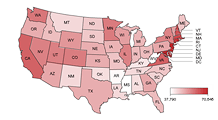Most mobile homes are in the south -- Census
Over half of the country's mobile homes are located in the southern region; two north Florida cities boast the highest density of mobile homes in any metro area.
| 30 yr fixed | 3.80% |
| 15 yr fixed | 3.20% |
| 5/1 ARM | 3.84% |
| 30 yr refi | 3.82% |
| 15 yr refi | 3.20% |
NEW YORK (CNNMoney.com) -- Most of the mobile homes in the U.S. are located in the south, where land is more plentiful, the weather is warmer, and rural poverty is higher.
The region is home to over 56% of the mobile housing units in the U.S., according to the U.S. Census Bureau's 2008 American Community Survey data released Monday.
Specifically, two cities outside of Jacksonville, Fla., had the country's highest concentration of mobile homes, which are generally about 12-feet wide and include a kitchen, a living and dining area, and one or two smaller bedrooms. While mobile homes make up only 6.17% of the nation's residences, they comprise 45.5% of the units in Palatka, Fla., and 41.6% of units in Lake City, Fla.
"Florida has an overheated housing market, especially with the recent bubble," said Jacob Vigdor, public policy and economics professor at Duke University. "In any area where housing is expensive, mobile homes can represent one of the few cheap options."
But high housing costs aren't the primary driver behind the large number of mobile homes in the southern U.S. Much of it has to do with the more sprawling nature of the Sun Belt cities that weren't developed until later in the 1950s, said Vigdor.
"You don't have to go far outside of a city like Charlotte to find trailer parks or single plots of land with mobile homes. Cities that grew up in the automobile age are naturally more hospitable to mobile homes," he said. "When land is inexpensive, you can get a parcel and put a mobile home on it for cheap."
And that notion is especially attractive to the south's poor, rural population.
"Mobile homes will make up a significant part of the housing market in any place you can find significant rural poverty," Vigdor said.
Land is less available in northern cities, which tend to be older and more densely built. Poverty in that region is concentrated in more urban areas. In fact, the New York and New Jersey metro areas have the country's lowest concentration of mobile homes, according to the survey.
Mobile homes are also more practical in the south simply due to the warmer weather there, since most units don't have much in the way of insulation.
Though mobile home residents are disproportionately poorer than the average population, not all of them are unable to afford homes.
For some, newer and larger mobile homes with modern amenities are a better option than living in an older, traditional home on the low-end of the market. Some triple wide mobile homes are closer to the size of traditional homes -- about 36 feet wide -- and start at about $100,000.
"Even though these people could afford to buy a house at that price, they probably couldn't afford one that's brand new with modern amenities," Vigdor said. "So sometimes a higher-end mobile home is the better option." ![]()




